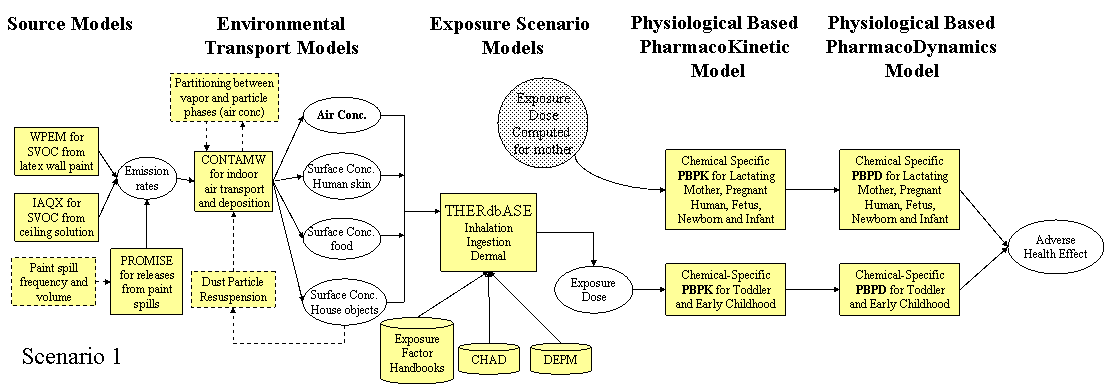
![]() 4.0 Scenarios
4.0 Scenarios
4.1 Life Stages
4.2 Scenario 1
Model Flow Diagram 1
4.3 Scenario 2
Model Flow Diagram 2
4.4 Scenario 3
Model Flow Diagram 3
4.5 Scenario 4
Model Flow Diagram 4
4.6 Process Flow
4.7 Gap Analysis

| Diagram Legend | |
|---|---|
| Solid boxes | Models with known codes available |
| Dashed boxes | Models with codes not available |
| Ovals | Input/output files with specific data specifications |
| Checkered Ovals | Output from separate scenario/input to this scenario |
| Cylinders | Model-Specific databases |
| Arrows | Indicates the flow of the data |
| PBPK | Physiologically-based Pharmacokinetics |
| PBPD | Physiologically-based Pharmacodynamics |
Notes
- Health effects will be calculated for the child from birth through year 18. Depending on model outputs, this can be a cumulative time distribution or a time-weighted value.
- WPEM was developed for latex or alkyd paint
- IAQX can be used for the solution on wood ceiling strips, since it is for emissions from building materials, including dry sources
- Indoor air transport modeling (SVOC emission) can be handled by many models, we selected CONTAM for this case, because it can handle aerosols and predicts airflows based on room sizes, but at least 4 other models identified in the literature review could be used. Some of the transport models are planning to add aerosol, and particle deposition components and in some cases separate models could handle deposition to product surface concentrations.
- THERdbASE is used to estimate human activity patterns and exposure doses. We would prefer to use LifeLine, Cares and other multi-route, multi-source models but it is difficult to integrate them because they are proprietary and much of the needed information is not readily available.
- DEPM includes information on food intake for estimating dietary exposure.
- CHAD is a master database that provides information on human activity.
- EPAís Exposure Factors Handbook for adults (http://www.epa.gov/ncea/exposfac.htm) and the Child-Specific Exposure Factors Handbook will be used as appropriate.
- Note that the exposure dose to the mother is assumed to have been computed by a different scenario and those results are incorporated into this scenario and feed to the PBPK/PBPD model for pregnant and nursing mothers.
- There are PBPK or PBPD model for each of the two chemicals of concern but only the ethylene glycol model was developed using a pregnant animal model (Sprague-Dawley rat). The 2-BE model was developed in an adult male.
- A PBPK model for a newborn or child could not be found and is necessary because of their unique characteristics.
- It should also be noted that interactions and competing causes of action could also be incorporated in the PBPK and PBPD models if the information were available
- LifeLine, CARES, and other lifestyle aggregate codes will overlay onto the PBPK, PBPD and Mode of Action models.
